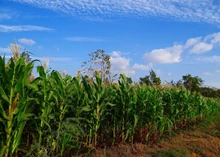
The Patent Office, Government of India, has granted patent for the technology, “Apparatus and Process for Extraction of Biopesticides from Cassava Biowastes.” This technology has been jointly developed by ICAR-CTCRI (Central Tuber Crops Research Institute) in collaboration with Kerala State Council for Science, Technology, and Environment (KSCSTE).
In one of our articles we talked about tuber crops as the next generation bio-fuels.Tapioca or Cassava is one of the promising tuber crop in this case. Now, as researched continued, scientists found that leaves of tapioca, which are often discarded, contain certain molecules that act as repellent for pests of horticultural crops.
It means that tapioca could also be the next generation biopesticides!
Tapioca as bio pesticide
Scientists have already experimented in this regard. In 2010, Principal Scientist of Crop Production division of ICAR-CTCRI, Dr. C. A. Jayaprakas et al developed bio pesticides from the leaves of this tuber crop.
According to the scientist, leaves of tapioca are usually discarded due to the presence of anti-nutrient factor called cyanogen. The scientist and his team separated bioactive molecules from the leaves to produce three biopesticides. Extensive field verification has revealed that these biopesticide are quite effective against a range of insect pests found in horticultural crops.
The three biopesticides developed are arbitrarily named Shreya, Menma, and Nanma.
According to the Acting Director of ICAR-CTCRI, patent application for biopesticide technology was filed in 2021. The ISRO (Indian Space Research Organization) facility – Vikram Sarabhai Space Center (VSSC) – played a key role in formulation of these three biopesticides. VSSC designed first generation machinery that was used in the process of extracting molecules from leaves.
“A treasure house of valuable molecules”
This is what Dr. Jayaprakas has to say. This is not all. Tapioca leaves also contain a range of vital molecules. In this regard, CTCRI is working in collaboration with BARC (Bhabha Atomic Research Center).
CTCRI has also produced bio-fumigant from leaves of tapioca.
There are more such astonishing discoveries and inventions to come in case of tuber crops, especially tapioca.
And this is not all, you can also make organic pesticides at home!












